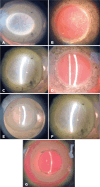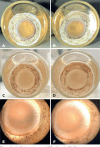Human cornea conservation in coconut water solution
- PMID: 33567016
- PMCID: PMC12289245
- DOI: 10.5935/0004-2749.20210027
Human cornea conservation in coconut water solution
Abstract
Purpose: The aim of this study was to evaluate the physical and chemical characteristics of coconut water and to analyze the use of coconut water solution for the conservation of human corneas.
Methods: This was an experimental and controlled study performed at the Eye Bank of the General Hospital of Fortaleza. The coconut water-based solution was prepared at the Goat Seed Technology Laboratory of the Department of Veterinary Medicine of the State University of Ceará. Discarded corneas from the Eye Bank were divided into two groups for sequential experiments: G1, coconut water-based solution (experimental group), and G2, conservative treatment with OPTISOL GS® (control group). The osmolality of corneas in G1 was analyzed sequentially at 275, 300, 325, 345, 365, and 400 mOsm/L. The viability of the corneas was determined by specular microscopy and biomicroscopy on the first, third, and seventh days.
Results: Corneas preserved in a solution of 365 and 345 mOsm/L had a transparency of 8 mm until the third day and had diffuse edema in the periphery, central folds, and partial epithelium loss until the seventh day. The 365-mOsm/L solution was associated with the worst results during follow-up. Corneas placed in Optisol-GS retained their original aspects.
Conclusions: Coconut water-based preservative partially maintained corneal transparency and epithelial integrity, especially during the first three days of follow-up. The coconut water-based solutions used were not effective for use as preservatives in a human eye bank.
Objetivos: As características físico-químicas e o baixo custo da água de coco foram fundamentais para o este estudo. Analisar o uso de solução a base de água de coco como meio de conservação de córneas humanas em banco de olhos.
Métodos:
Estudo experimental e controlado realizado no Banco de Olhos do Hospital Geral de Fortaleza. Utilizou-se solução à base de água de coco preparada no laboratório de Tecnologia de Sêmen de Caprinos do Departamento de Medicina Veterinária da Universidade Estadual do Ceará. Foram usadas córneas de descartes divididas em dois grupos: G1 (Conservante com água de coco) - grupo experimental e G2 (grupo Conservante com OPTISOL GS®) grupo controle, em experimentos sequenciais. A osmolaridade do G1 foi analisada sequencialmente com 275, 300, 325, 345, 365 e 400 mOsm/L. A viabilidade das córneas foram realizadas por microscopia especular e biomicroscopia nos 1
Resultados:
As córneas em solução de 365 e 345 mOsm/L apresentavam transparência nos 8mm centrais até o 3
Conclusões: O conservante à base de água de coco manteve em parte a transparência corneana e a integridade epitelial, especialmente nos primeiros 3 dias de seguimento. A solução conservante com água de coco nas formulações utilizadas não se mostrou eficaz para o uso em banco de olhos humanos.
Conflict of interest statement
Figures




References
-
- Bowling BK. Oftalmologia clínica: uma abordagem sistemática. 8a. Rio de Janeiro: Elsevier;; 2016. cap. 6.
-
- Sano FT, Dantas PE, Silvino WR, Sanchez JZ, Sano RY, Adams F, et al. Tendência de mudança nas indicações de transplante penetrante de córnea. Arq Bras Oftalmol. 2008;71(3):400–404. - PubMed
-
- Mascaro VL, Scarpi MJ, Hofling-Lima AL, de Sousa LB. Transplante de córnea em ceratocone: avaliação dos resultados e complicações obtidos por cirurgiões experientes e em treinamento. Arq Bras Oftalmol. 2007;70(3):395–405. - PubMed
-
- Ang M, Soh Y, Htoon HM, Mehta JS, Tan D. Five-year graft survival comparing descemet stripping automated endothelial keratoplasty and penetrating keratoplasty. Ophthalmology. 2016;123(8):1646–1652. - PubMed
-
- McCarey BE, Kaufman HE. Improved corneal storage. Invest Ophthalmol. 1974;13(3):165–173. - PubMed
MeSH terms
Substances
LinkOut - more resources
Full Text Sources
Other Literature Sources

